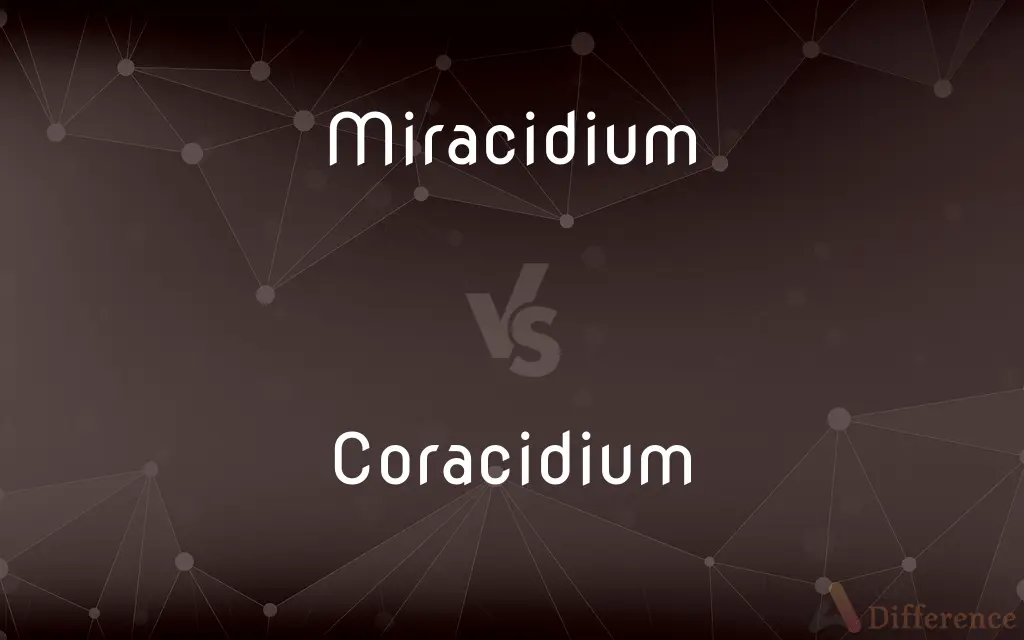Miracidium vs. Coracidium — What's the Difference?
By Maham Liaqat & Urooj Arif — Updated on March 27, 2024
Miracidium and coracidium are both larval stages in life cycles of parasitic flatworms, but miracidia are free-swimming larvae that infect snails directly, while coracidia are ciliated larvae that hatch from eggs in water and must be ingested by copepods.

Difference Between Miracidium and Coracidium
Table of Contents
ADVERTISEMENT
Key Differences
Miracidium is a ciliated, free-swimming larval form of certain parasitic flatworms, particularly those in the class Trematoda (flukes). These larvae are released into the environment, where they actively seek out and penetrate the soft tissues of specific snail hosts, initiating the next stage of the parasite's lifecycle. On the other hand, coracidium is the larval stage of cestodes (tapeworms) that hatch from eggs expelled with the feces of infected definitive hosts into water. Coracidia must then be consumed by intermediate hosts, typically copepods, to develop further.
The primary function of a miracidium is to locate and infect a suitable snail host as quickly as possible after hatching, as their lifespan outside a host is very limited, often only a few hours. They are equipped with sensory structures to detect their hosts. Conversely, coracidia rely on being ingested by the right kind of small crustaceans to continue their development. They do not actively infect their hosts but must be eaten to progress to the next larval stage.
In terms of morphology, both miracidia and coracidia are ciliated, which helps them move through their aquatic environments. However, the structures and adaptations of these larvae differ to suit their distinct modes of infection. Miracidia often have specialized glands and organs for penetration and evasion of host defenses, whereas coracidia are primarily designed to survive in water until ingested.
While both miracidium and coracidium stages are critical for the transmission and continuation of their respective parasitic life cycles, the specific strategies and adaptations of each highlight the diversity of parasitic survival strategies in nature. The miracidium’s direct penetration of its host contrasts with the coracidium's passive ingestion by its host, illustrating the varied paths parasites have evolved to exploit their ecological niches.
Comparison Chart
Definition
Larval stage of flukes, free-swimming, infects snails.
Larval stage of tapeworms, hatches in water, ingested by copepods.
ADVERTISEMENT
Hosts
Directly infects specific snail hosts.
Must be ingested by copepods to continue lifecycle.
Lifespan
Very short, hours, until infecting a host.
Survives in water until consumed by intermediate host.
Function
Seeks out and penetrates snail hosts.
Awaits ingestion by suitable crustacean host.
Adaptations
Equipped with sensory and penetration structures.
Designed to survive in water, lacks penetration structures.
Role in Lifecycle
Initiates infection in intermediate host.
Intermediate stage, requires ingestion to develop further.
Ecological Strategy
Active host infection.
Passive transmission through ingestion.
Infection Mechanism
Uses cilia for movement, has organs for host penetration.
Relies on being eaten by intermediate host, uses cilia for movement.
Compare with Definitions
Miracidium
Equipped with cilia and penetration glands.
Upon finding a snail, the miracidium uses its glands to enter the host.
Coracidium
Relies on passive transmission to intermediate hosts.
The survival of a coracidium depends on being consumed by the right host.
Miracidium
A free-swimming larva of flukes that infects snails.
The miracidium rapidly swims to find a snail host before it dies.
Coracidium
Hatches from eggs released into water.
Eggs from an infected host release coracidia upon reaching water.
Miracidium
Has a very limited lifespan outside a host.
If a miracidium doesn’t find a snail within hours, it perishes.
Coracidium
The larval form of tapeworms that must be eaten by copepods.
Coracidia hatch in water and float until ingested by a crustacean.
Miracidium
Specific to snail hosts.
Each species of miracidium is adapted to infect a particular type of snail.
Coracidium
Marks the beginning of a tapeworm’s lifecycle.
Once ingested by a copepod, the coracidium develops further.
Miracidium
Initiates the complex lifecycle of flukes.
After infecting a snail, the miracidium develops into the next larval stage.
Coracidium
Does not actively infect hosts.
Coracidia must be eaten by copepods to continue their development.
Miracidium
The Miracidium is the second stage in the life cycle of trematodes. When trematode eggs are laid and come into contact with fresh water, they hatch and release miracidium.
Coracidium
(biology) The larval stage of some tapeworms
Miracidium
A ciliated larva of a digenetic trematode, which hatches from the egg and enters the first intermediate host, where it develops into a sporocyst or a redia.
Miracidium
(biology) A free-living motile form of a trematode, covered with cilia, which settles in a mollusc intermediate host to become a sporocyst
Common Curiosities
What is the lifespan of a miracidium?
The lifespan of a miracidium outside a host is very short, typically only a few hours.
How do miracidia find their hosts?
Miracidia use sensory structures to detect and actively seek out their snail hosts.
Can coracidia infect any aquatic organism?
No, coracidia must be ingested specifically by copepods to develop into the next lifecycle stage.
What is a miracidium?
A miracidium is a free-swimming larval stage of flukes that infects specific snail hosts.
How does a coracidium infect its host?
A coracidium does not actively infect but must be ingested by a copepod to continue its development.
Why is the coracidium stage important for tapeworms?
The coracidium stage is crucial as it needs to be consumed by a copepod to progress to the next stage in the tapeworm's lifecycle.
What adaptations do miracidia have?
Miracidia are equipped with cilia for movement and specialized glands for penetrating snail hosts.
Are coracidia able to swim?
Yes, coracidia are ciliated and can swim in water, but they rely on being ingested to infect their hosts.
What happens after a miracidium infects a snail?
After infection, the miracidium develops into further larval stages within the snail, continuing the fluke's lifecycle.
What role does the coracidium play in the tapeworm's lifecycle?
The coracidium is an early larval stage that must be eaten by copepods to develop into the next tapeworm's lifecycle.
Share Your Discovery

Previous Comparison
Alphabet vs. Word
Next Comparison
Indispensable vs. InvaluableAuthor Spotlight
Written by
Maham LiaqatCo-written by
Urooj ArifUrooj is a skilled content writer at Ask Difference, known for her exceptional ability to simplify complex topics into engaging and informative content. With a passion for research and a flair for clear, concise writing, she consistently delivers articles that resonate with our diverse audience.















































